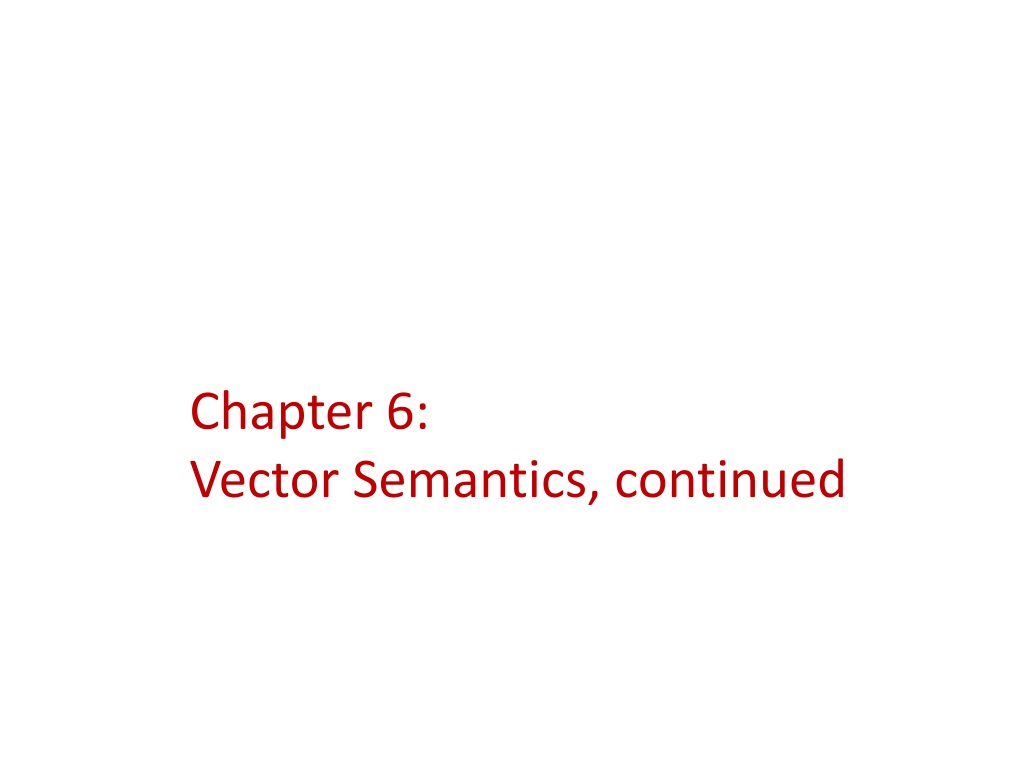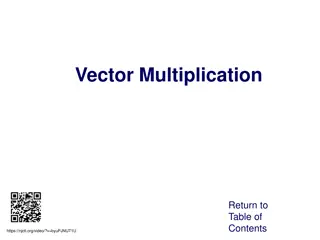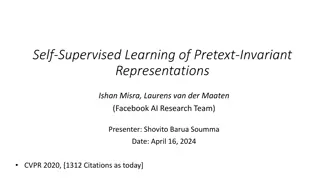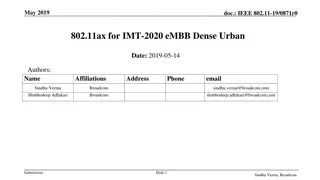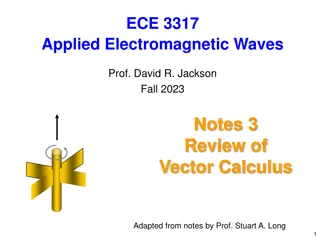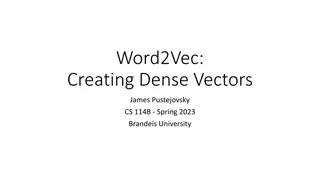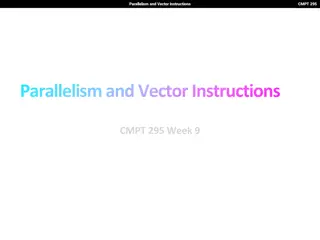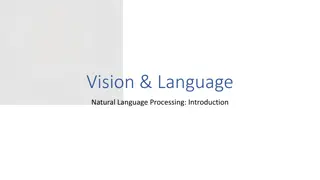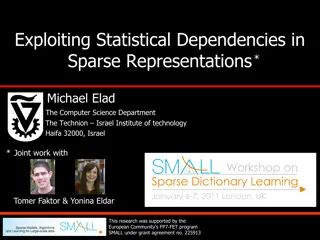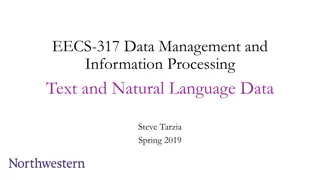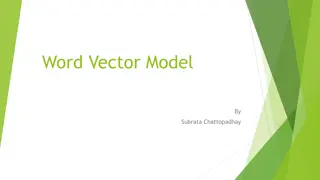Understanding Sparse vs. Dense Vector Representations in Natural Language Processing
Tf-idf and PPMI are sparse representations, while alternative dense vectors offer shorter lengths with non-zero elements. Dense vectors may generalize better and capture synonymy effectively compared to sparse ones. Learn about dense embeddings like Word2vec, Fasttext, and Glove, which provide efficient methods for training and predicting word embeddings in NLP tasks.
Download Presentation

Please find below an Image/Link to download the presentation.
The content on the website is provided AS IS for your information and personal use only. It may not be sold, licensed, or shared on other websites without obtaining consent from the author. Download presentation by click this link. If you encounter any issues during the download, it is possible that the publisher has removed the file from their server.
E N D
Presentation Transcript
Chapter 6: Vector Semantics, continued
Tf-idf and PPMI are sparse representations tf-idf and PPMI vectors are long (length |V|= 20,000 to 50,000) sparse (most elements are zero)
Alternative: dense vectors vectors which are short (length 50-1000) dense (most elements are non-zero) 3
Sparse versus dense vectors Why dense vectors? Short vectors may be easier to use as features in machine learning (less weights to tune) Dense vectors may generalize better than storing explicit counts They may do better at capturing synonymy: car and automobile are synonyms; but are distinct dimensions a word with car as a neighbor and a word with automobile as a neighbor should be similar, but aren't In practice, they work better 4
Dense embeddings you can download! Word2vec (Mikolov et al.) https://code.google.com/archive/p/word2vec/ Fasttext http://www.fasttext.cc/ Glove (Pennington, Socher, Manning) http://nlp.stanford.edu/projects/glove/
Word2vec Popular embedding method Very fast to train Code available on the web Idea: predict rather than count
Word2vec Instead of counting how often each word w occurs near "apricot" Train a classifier on a binary prediction task: Is w likely to show up near "apricot"? We don t actually care about this task But we'll take the learned classifier weights as the word embeddings
Insight: Use running text as implicitly supervised training data! A word s near apricot Acts as gold correct answer to the question Is word w likely to show up near apricot? No need for hand-labeled supervision
Word2Vec: Skip Skip- -Gram Gram Task Word2vec provides a variety of options. Let's do "skip-gram with negative sampling" (SGNS)
Skip-gram algorithm 1. Treat the target word and a neighboring context word as positive examples. 2. Randomly sample other words in the lexicon to get negative samples 3. Use logistic regression to train a classifier to distinguish those two cases 4. Use the weights as the embeddings 10 8/31/2024
Skip-Gram Training Data Training sentence: ... lemon, a tablespoon of apricot jam a pinch ... c1 c2 target c3 c4 Asssume context words are those in +/- 2 word window 11 8/31/2024
Skip-Gram Goal Given a tuple (t,c) = target, context (apricot, jam) (apricot, aardvark) Return probability that c is a real context word: P(+|t,c) P( |t,c) = 1 P(+|t,c) 12 8/31/2024
How to compute p(+|t,c)? Intuition: Words are likely to appear near similar words Model similarity with dot-product! Similarity(t,c) t c Problem: Dot product is not a probability! (Neither is cosine)
Turning dot product into a probability The sigmoid lies between 0 and 1:
Turning dot product into a probability
For all the context words: Assume all context words are independent
Skip-Gram Training Data Training sentence: ... lemon, a tablespoon of apricot jam a pinch ... c1 c2 t c3 c4 Training data: input/output pairs centering on apricot Asssume a +/- 2 word window 17 8/31/2024
Skip-Gram Training Training sentence: ... lemon, a tablespoon of apricot jam a pinch ... c1 c2 t c3 c4 For each positive example, we'll create k negative examples. Using noise words Any random word that isn't t 18 8/31/2024
Skip-Gram Training Training sentence: ... lemon, a tablespoon of apricot jam a pinch ... c1 c2 t c3 c4 k=2 19 8/31/2024
Choosing noise words Could pick w according to their unigram frequency P(w) More common to chosen then according to p (w) = works well because it gives rare noise words slightly higher probability To show this, imagine two events p(a)=.99 and p(b) = .01:
Setup Let's represent words as vectors of some length (say 300), randomly initialized. So we start with 300 * V random parameters Over the entire training set, we d like to adjust those word vectors such that we Maximize the similarity of the target word, context word pairs (t,c) drawn from the positive data Minimize the similarity of the (t,c) pairs drawn from the negative data. 21 8/31/2024
Learning the classifier Iterative process. We ll start with 0 or random weights Then adjust the word weights to make the positive pairs more likely and the negative pairs less likely over the entire training set:
Objective Criteria We want to maximize Maximize the + label for the pairs from the positive training data, and the label for the pairs sample from the negative data. 23 8/31/2024
Train using gradient descent Actually learns two separate embedding matrices W and C Can use W and throw away C, or merge them somehow
Summary: How to learn word2vec (skip-gram) embeddings Start with V random 300-dimensional vectors as initial embeddings Use logistic regression, the second most basic classifier used in machine learning after na ve bayes Take a corpus and take pairs of words that co-occur as positive examples Take pairs of words that don't co-occur as negative examples Train the classifier to distinguish these by slowly adjusting all the embeddings to improve the classifier performance Throw away the classifier code and keep the embeddings.
Evaluating embeddings Compare to human scores on word similarity-type tasks: WordSim-353 (Finkelstein et al., 2002) SimLex-999 (Hill et al., 2015) Stanford Contextual Word Similarity (SCWS) dataset (Huang et al., 2012) TOEFL dataset: Levied is closest in meaning to: imposed, believed, requested, correlated
Properties of embeddings Similarity depends on window size C C = 2 The nearest words to Hogwarts: Sunnydale Evernight C = 5 The nearest words to Hogwarts: Dumbledore Malfoy halfblood 29
Analogy: Embeddings capture relational meaning! vector( king ) - vector( man ) + vector( woman ) vector( queen ) vector( Paris ) - vector( France ) + vector( Italy ) vector( Rome ) 30
Word embeddings for studying language change! Word vectors 1990 Word vectors for 1920 dog 1990 word vector dog 1920 word vector vs. 1950 2000 1900 3 3
Visualizing changes Project 300 dimensions down into 2 ~30 million books, 1850-1990, Google Books data
Embeddings reflect cultural bias Bolukbasi, Tolga, Kai-Wei Chang, James Y. Zou, Venkatesh Saligrama, and Adam T. Kalai. "Man is to computer programmer as woman is to homemaker? debiasing word embeddings." In Advances in Neural Information Processing Systems, pp. 4349-4357. 2016. Ask Paris : France :: Tokyo : x x = Japan Ask father : doctor :: mother : x x = nurse Ask man : computer programmer :: woman : x x = homemaker
Embeddings reflect cultural bias Caliskan, Aylin, Joanna J. Bruson and Arvind Narayanan. 2017. Semantics derived automatically from language corpora contain human-like biases. Science 356:6334, 183-186. Implicit Association test (Greenwald et al 1998): How associated are concepts (flowers, insects) & attributes (pleasantness, unpleasantness)? Studied by measuring timing latencies for categorization. Psychological findings on US participants: African-American names are associated with unpleasant words (more than European- American names) Male names associated more with math, female names with arts Old people's names with unpleasant words, young people with pleasant words. Caliskan et al. replication with embeddings: African-American names (Leroy, Shaniqua) had a higher GloVe cosine with unpleasant words (abuse, stink, ugly) European American names (Brad, Greg, Courtney) had a higher cosine with pleasant words (love, peace, miracle) Embeddings reflect and replicate all sorts of pernicious biases.
Directions Debiasing algorithms for embeddings Bolukbasi, Tolga, Chang, Kai-Wei, Zou, James Y., Saligrama, Venkatesh, and Kalai, Adam T. (2016). Man is to computer programmer as woman is to homemaker? debiasing word embeddings. In Advances in Neural Infor- mation Processing Systems, pp. 4349 4357. Use embeddings as a historical tool to study bias
Embeddings as a window onto history Garg, Nikhil, Schiebinger, Londa, Jurafsky, Dan, and Zou, James (2018). Word embeddings quantify 100 years of gender and ethnic stereotypes. Proceedings of the National Academy of Sciences, 115(16), E3635 E3644 The cosine similarity of embeddings for decade X for occupations (like teacher) to male vs female names Is correlated with the actual percentage of women teachers in decade X
History of biased framings of women Garg, Nikhil, Schiebinger, Londa, Jurafsky, Dan, and Zou, James (2018). Word embeddings quantify 100 years of gender and ethnic stereotypes. Proceedings of the National Academy of Sciences, 115(16), E3635 E3644 Embeddings for competence adjectives are biased toward men Smart, wise, brilliant, intelligent, resourceful, thoughtful, logical, etc. This bias is slowly decreasing
Embeddings reflect ethnic stereotypes over time Garg, Nikhil, Schiebinger, Londa, Jurafsky, Dan, and Zou, James (2018). Word embeddings quantify 100 years of gender and ethnic stereotypes. Proceedings of the National Academy of Sciences, 115(16), E3635 E3644 Princeton trilogy experiments Attitudes toward ethnic groups (1933, 1951, 1969) scores for adjectives industrious, superstitious, nationalistic, etc Cosine of Chinese name embeddings with those adjective embeddings correlates with human ratings.
Change in linguistic framing 1910-1990 Garg, Nikhil, Schiebinger, Londa, Jurafsky, Dan, and Zou, James (2018). Word embeddings quantify 100 years of gender and ethnic stereotypes. Proceedings of the National Academy of Sciences, 115(16), E3635 E3644 Change in association of Chinese names with adjectives framed as "othering" (barbaric, monstrous, bizarre)
Changes in framing: adjectives associated with Chinese Garg, Nikhil, Schiebinger, Londa, Jurafsky, Dan, and Zou, James (2018). Word embeddings quantify 100 years of gender and ethnic stereotypes. Proceedings of the National Academy of Sciences, 115(16), E3635 E3644
Conclusion Concepts or word senses Have a complex many-to-many association with words (homonymy, multiple senses) Have relations with each other Synonymy, Antonymy, Superordinate But are hard to define formally (necessary & sufficient conditions) Embeddings = vector models of meaning More fine-grained than just a string or index Especially good at modeling similarity/analogy Just download them and use cosines!! Can use sparse models (tf-idf) or dense models (word2vec, GLoVE) Useful in practice but know they encode cultural stereotypes
